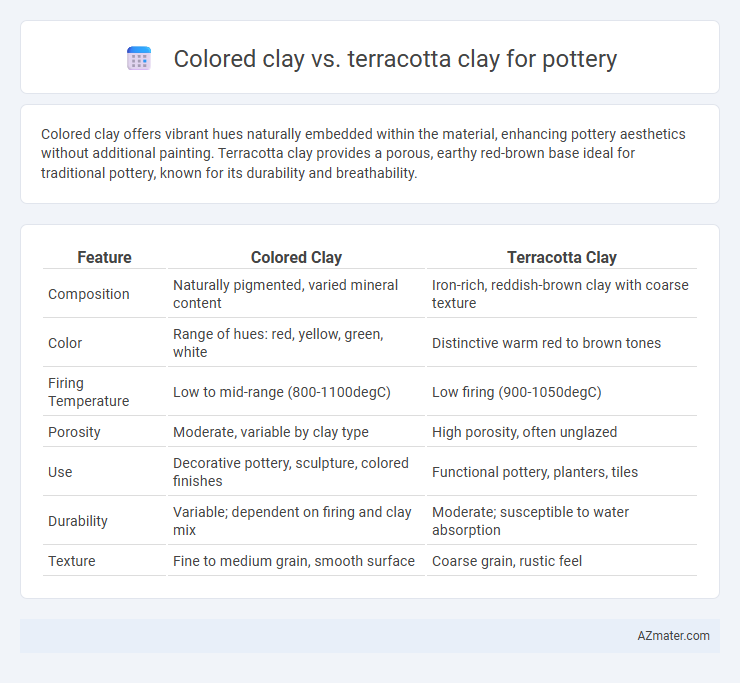Colored clay offers vibrant hues naturally embedded within the material, enhancing pottery aesthetics without additional painting. Terracotta clay provides a porous, earthy red-brown base ideal for traditional pottery, known for its durability and breathability.
Table of Comparison
| Feature | Colored Clay | Terracotta Clay |
|---|---|---|
| Composition | Naturally pigmented, varied mineral content | Iron-rich, reddish-brown clay with coarse texture |
| Color | Range of hues: red, yellow, green, white | Distinctive warm red to brown tones |
| Firing Temperature | Low to mid-range (800-1100degC) | Low firing (900-1050degC) |
| Porosity | Moderate, variable by clay type | High porosity, often unglazed |
| Use | Decorative pottery, sculpture, colored finishes | Functional pottery, planters, tiles |
| Durability | Variable; dependent on firing and clay mix | Moderate; susceptible to water absorption |
| Texture | Fine to medium grain, smooth surface | Coarse grain, rustic feel |
Introduction to Colored Clay and Terracotta Clay
Colored clay features natural mineral pigments that provide a diverse palette, making it ideal for decorative pottery and artistic expression. Terracotta clay is a type of earthenware characterized by its reddish-brown hue, rich iron oxide content, and porous texture, commonly used for functional ceramics and garden pottery. Both clays offer unique firing properties and finishes, influencing the durability and aesthetic of the final pottery pieces.
What is Colored Clay?
Colored clay is natural clay infused with minerals and oxides that impart various hues, such as reds, yellows, greens, and blues, without the need for surface glazing. It offers potters a vibrant palette directly in the clay body, enhancing artistic possibilities and durability since the color penetrates the entire piece. Unlike terracotta clay, which typically has a characteristic reddish-brown tone due to iron content, colored clay provides a broader spectrum of inherent colors suited for diverse pottery styles.
What is Terracotta Clay?
Terracotta clay is a type of earthenware clay characterized by its reddish-brown color due to high iron content, commonly used for pottery and sculptures. It fires at a relatively low temperature, typically between 1000degC and 1150degC, resulting in a porous, durable material ideal for functional and decorative items. Colored clay differs by incorporating various mineral oxides or pigments to achieve diverse hues, offering greater aesthetic variety beyond the natural terra cotta shade.
Key Differences: Colored Clay vs Terracotta Clay
Colored clay contains natural or synthetic pigments, offering a wide range of vibrant hues ideal for artistic pottery projects, whereas terracotta clay is traditionally reddish-brown due to its iron oxide content, favored for its rustic and earthy appearance. Terracotta clay fires at lower temperatures and is porous after firing, making it suitable for decorative items and garden pots, while colored clay can vary in firing temperature and tends to have a denser, less porous finish. The key differences lie in color variety, firing properties, and porosity, influencing the final texture, durability, and intended use of the pottery pieces.
Workability and Handling
Colored clay offers enhanced workability due to its pre-mixed pigments that maintain a consistent texture, making it ideal for detailed pottery designs. Terracotta clay, known for its coarse and porous composition, provides excellent plasticity but can be more challenging to handle during intricate shaping. Potters often prefer colored clay for smoother handling and vibrant finishes, while terracotta remains favored for rustic, durable ware.
Color Range and Aesthetic Appeal
Colored clay offers a broader spectrum of hues, allowing potters to achieve vibrant, customized finishes without relying on glazes, making each piece uniquely expressive. Terracotta clay, characterized by its warm, earthy red-brown tone, provides a classic, rustic aesthetic favored in traditional pottery and sculpture. While terracotta's natural color enhances organic textures, colored clays enable more diverse artistic experimentation and visual impact in ceramic art.
Firing Temperatures and Techniques
Colored clay typically contains added minerals or stains that can influence its firing temperature, generally ranging between 1,000degC to 1,200degC, allowing for vivid hues post-firing. Terracotta clay, known for its rich iron content, fires at lower temperatures, usually between 900degC to 1,100degC, resulting in its characteristic reddish-brown color and porous texture. Techniques such as oxidation firing enhance terracotta's warm tones, while reduction firing can intensify the color variations in colored clay, highlighting its versatility in pottery.
Durability and Finished Pottery Quality
Colored clay often contains added pigments that may affect the firing temperature and durability, potentially resulting in pottery with vibrant hues but slightly less structural strength compared to terracotta. Terracotta clay, known for its porous and relatively soft nature, typically produces durable pottery ideal for functional items, offering a warm, earthy finish that enhances the aesthetic quality of the final piece. The finished quality of terracotta pottery usually exhibits better resistance to chipping and cracking, while colored clay pottery excels in decorative appeal but may require careful handling during firing to maintain durability.
Applications and Recommended Uses
Colored clay offers versatility for decorative pottery, allowing artists to create vibrant, multicolored pieces without additional glazing, ideal for detailed sculptures and artisan tableware. Terracotta clay, known for its porous and earthy texture, excels in functional pottery such as garden pots, cookware, and rustic home decor that benefit from its breathability and durability. Both clays suit wheel throwing and hand-building techniques but differ in firing temperatures and finishing, making colored clays preferable for fine art and terracotta optimal for practical, everyday pottery items.
Choosing the Right Clay for Your Pottery Project
Colored clay offers vibrant natural hues and requires minimal glazing, making it ideal for decorative pottery that highlights earthy tones. Terracotta clay, known for its porous, orange-red finish, is favored for functional ware due to its excellent workability and durability after firing. Selecting the right clay depends on your project's aesthetic goals and functional requirements, with colored clay providing varied surface appeal and terracotta delivering classic strength and rustic charm.

Infographic: Colored clay vs Terracotta clay for Pottery
 azmater.com
azmater.com